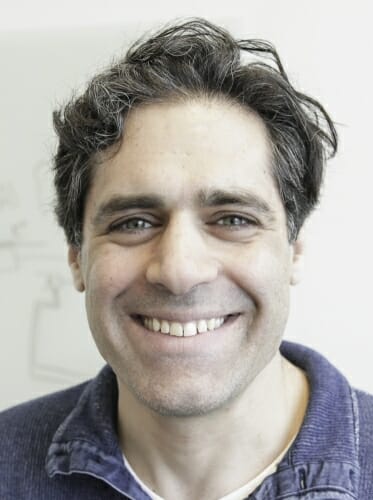New Innovator Award winner looking for unprecedented view of the brain
In order to read this sentence, multiple parts of your brain must work together, teaming up in a matter of milliseconds to string together letters into words and process their meaning.
And it’s not just cognitive tasks that span the brain’s regions; neurological disease and dysfunction do, too. But when neuroscientists or clinicians want to track that activity, their options are limited to tools that either don’t directly record neural activity (like functional MRI) or require deeply invasive surgical procedures to provide merely a localized view (like electrode arrays).
Aviad Hai, an assistant professor of biomedical engineering at the University of Wisconsin–Madison, is developing injectable, wireless electronics that could circumvent those deficiencies, offering a global look at the actual electrical activity of the brain without the need for surgical procedures.
Hai will use a National Institutes of Health Director’s New Innovator Award to pursue the ambitious project. The award, part of NIH’s High-Risk, High-Reward Research Program, supports early career researchers undertaking pioneering work that holds great promise.
“The breadth of innovative science put forth by the 2020 cohort of early career and seasoned investigators is impressive and inspiring,” said NIH Director Francis S. Collins. “I am confident that their work will propel biomedical and behavioral research and lead to improvements in human health.”
Hai’s injectable electrodes project is one of 53 New Innovator Awards Collins announced today.
“Electrodes have given us a wealth of information about the neural code, the signaling, the commands that are being sent from the brain to other parts of the brain and to our peripheral nervous system,” says Hai. “Electrodes have been able to do that for just a very, very small region. So we’re actually blind to everything else. How do we break through this technological barrier? We need something that doesn’t require wires and is very small but still sensitive enough to talk to the outside hardware.”
With the five-year grant of nearly $2.3 million, Hai and his lab members will use nanoscale lithography — etching or printing things measured in millionths of a meter (or less) — and fabrication techniques to create devices that consist of antennae and connected sensors. Those electronics can detect electromagnetic signals from deep within the brain and wirelessly communicate with MRI scanners, adding detail and contrast to scans.
Hai’s group also plans to explore techniques to traverse the blood-brain barrier, as well as recording from brain vasculature, which he says would yield unprecedented data.
He sees particular relevancy for the technology in studying epileptic seizures, building off a previous NIH grant, where it could deliver direct readouts of electrophysiological signals as opposed to tracking blood flow, as functional MRI traditionally does.
“Now you would be able to say more than just, ‘There’s blood flowing into this area.’ Does that correlate with a seizure? Maybe,” he says. “The idea is to be able to say what is the signaling that is actually happening there.”
As a member of the nascent Wisconsin Institute for Translational Neuroengineering—along with biomedical engineering colleagues Kip Ludwig and Justin Williams and neurological surgery researchers Aaron Suminski and Wendell Lake — Hai says the project dovetails nicely with the group’s philosophy of creating minimally invasive technologies with which to access the nervous system.
“We work to move away from those bulky, invasive techniques,” says Hai, who is also an affiliate of the Department of Electrical and Computer Engineering and part of the Grainger Institute for Engineering at UW–Madison. “We’re trying to solve these longstanding problems with brain technologies.”
Hai is the second UW–Madison biomedical engineering faculty member to receive the NIH Director’s New Innovator Award. Pamela Kreeger did in 2014.
Hai’s project is funded by NIH grant number DP2 NS122605-01 through the National Institute of Neurological Disorders and Stroke.

